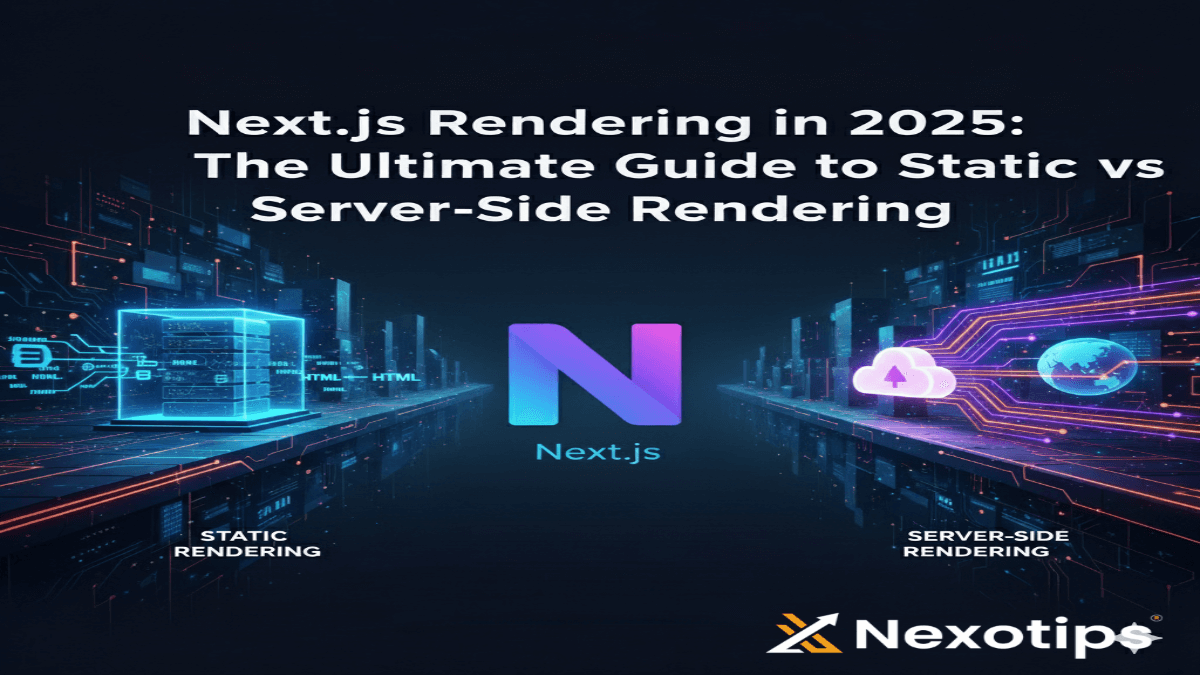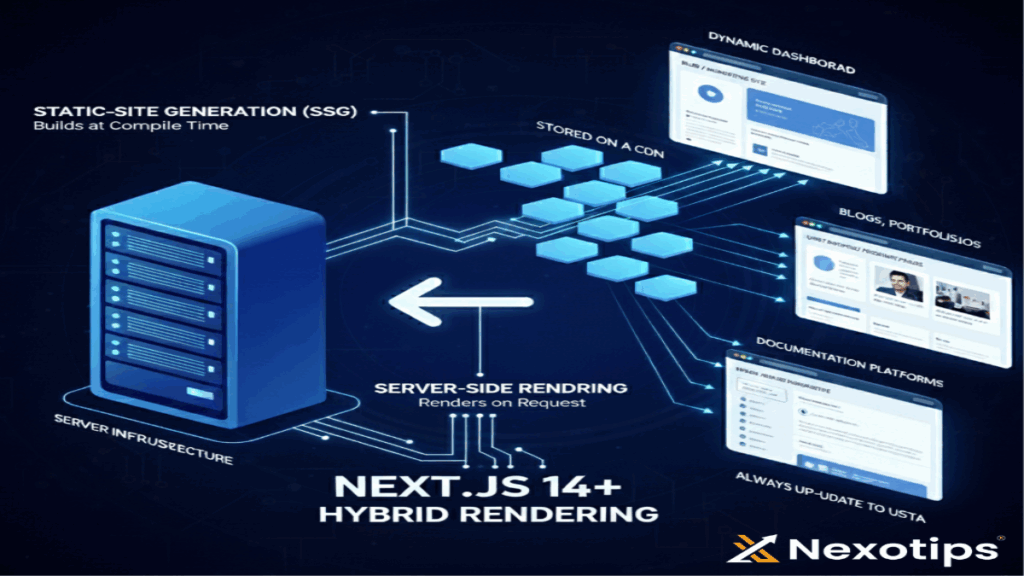
Next.js Rendering in 2025: The Ultimate Guide to Static vs Server-Side Rendering
In 2025, Next.js Rendering has become the foundation of high-performance web development. Whether you’re an individual developer or a growing business, understanding how pages are rendered — statically or on the server — helps you build faster, scalable, and SEO-optimized websites.
At Nexotips Infotech, we specialize in crafting powerful Next.js projects and helping teams determine the best approach between Static Site Generation (SSG), Server-Side Rendering (SSR), and hybrid rendering, based on project needs.
Table of Contents
Introduction to Next.js Rendering
Rendering defines how your app’s pages are prepared before reaching the browser. In Next.js Rendering, developers can choose from multiple methods — including Static Generation, Server-Side Rendering, and Incremental Static Regeneration (ISR).
According to the Official Next.js Documentation, rendering plays a vital role in optimizing both speed and SEO. Understanding these methods ensures you deliver content efficiently and dynamically in 2025.
What Is Rendering in Web Development?
Rendering is the process of converting React components into HTML for users to view. Traditional Client-Side Rendering (CSR) relies on the browser to build pages after JavaScript loads, but Next.js Rendering changes that — it allows developers to decide where and when HTML should be generated.
This flexibility makes it ideal for building blogs, dashboards, and large-scale applications that balance performance with dynamic content.
Static Site Generation (SSG) Explained

Static Site Generation (SSG) builds HTML at build time. Each page is generated once, stored on a CDN, and served instantly to users.
SSG is perfect for:
- Blogs, portfolios, and marketing sites
- Documentation platforms
- Content that rarely changes
At Nexotips Infotech, we often recommend SSG for performance-focused projects where load speed is the top priority. It’s also what we use in guides like How to Build Forms in Next.js to ensure instant page loads and seamless UX.
Example:
export async function getStaticProps() {
const posts = await fetchPosts();
return { props: { posts } };
}This code generates static HTML during the build and reuses it across all users.
Server-Side Rendering (SSR) Explained

Server-Side Rendering (SSR), on the other hand, builds the page on demand — each request triggers a new render on the server before sending HTML to the browser.
It’s perfect for:
- Dynamic dashboards
- E-commerce platforms with live inventory
- Real-time analytics or user-specific data
Example:
export async function getServerSideProps(context) {
const data = await fetchData(context.params.id);
return { props: { data } };
}This ensures every visitor gets up-to-date, SEO-optimized content.
Key Differences Between SSG and SSR
| Feature | Static Site Generation (SSG) | Server-Side Rendering (SSR) |
|---|---|---|
| Rendering Time | Build time | Per request |
| Performance | Faster | Slightly slower |
| SEO | Excellent | Excellent |
| Hosting | CDN | Node.js server |
| Ideal For | Blogs, docs | Dynamic dashboards |
Both methods excel in Next.js Rendering, but your choice depends on your content update frequency and personalization needs.
When to Use Static Site Generation (SSG)
Use SSG when:
- Data changes infrequently
- You need ultra-fast page loads
- You’re targeting global users
Example websites: Blogs, documentation portals, and portfolios.
At Nexotips Infotech, we often recommend SSG for marketing-heavy projects.
When to Use Server-Side Rendering (SSR)
Use SSR when:
- You need dynamic, personalized content
- Real-time data is essential
- SEO is critical for frequently updated pages
For example, an e-commerce site displaying live pricing benefits from SSR. Our Next.js Routing Guide 2025 explores how SSR pairs with dynamic routes for user-specific content without sacrificing SEO.
Hybrid Rendering in Next.js 14 and Beyond

With Next.js 14, hybrid rendering allows developers to combine SSG, SSR, and ISR on the same site.
You can pre-render marketing pages statically while dynamically generating dashboard data. According to Vercel’s Blog on Performance, hybrid rendering helps developers achieve both speed and freshness — a balance that defines modern Next.js Rendering in 2025.
👉 Example configuration:
/home→ Static/blog/[id]→ ISR/dashboard→ SSR
This flexibility ensures you only pay the rendering cost where necessary.
Performance and SEO Impact
Static pages offer instant loading and exceptional Core Web Vitals scores. However, SSR supports real-time updates and personalized SEO for dynamic pages.
To maximize performance:
- Use
next/imagefor image optimization - Cache SSR responses
- Analyze page metrics with Vercel Analytics
At Nexotips Infotech, we continuously optimize these metrics across projects to ensure our clients’ sites stay fast, responsive, and search engine-friendly.
Rendering Best Practices
The following practices can elevate your Next.js Rendering setup:
- Adopt ISR (Incremental Static Regeneration) for frequently updated content
- Use edge caching with Vercel Edge Functions
- Preload fonts and compress static assets
- Leverage React Server Components for lighter bundles
- Run Lighthouse audits for every release
These strategies, when paired with modern routing and component management, give your site a significant SEO and performance edge.
Final Thoughts
As of 2025, Next.js Rendering has matured into a versatile ecosystem that balances speed, scalability, and real-time interactivity. By choosing the right rendering approach — or combining them — you can deliver lightning-fast, SEO-optimized web experiences that delight users worldwide.
At Nexotips Infotech, we believe the future of web performance lies in mastering these rendering patterns and aligning them with your project goals. Whether you’re optimizing for SEO, personalizing data, or building for scale, a strong grasp of Next.js Rendering will set your product apart.
Want to learn more? Check out our other coding-related blogs on the Nexotips blog.
